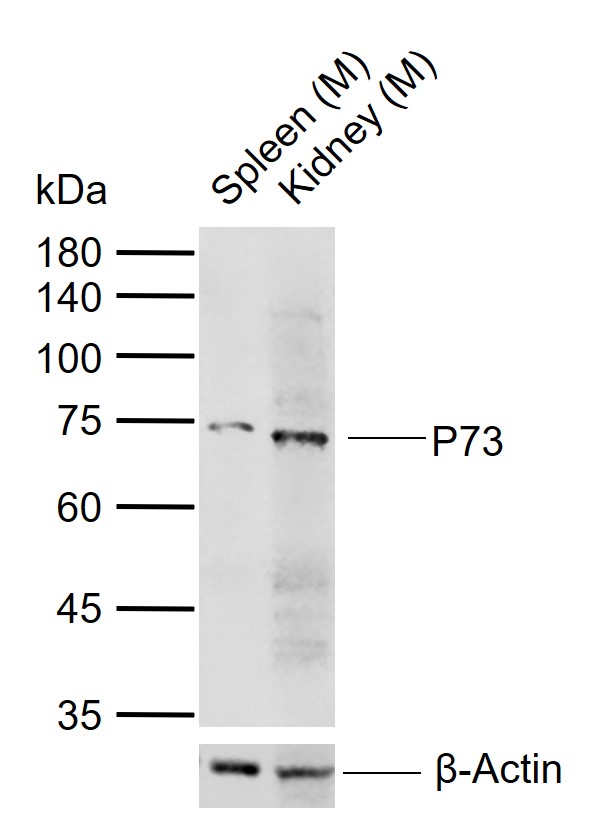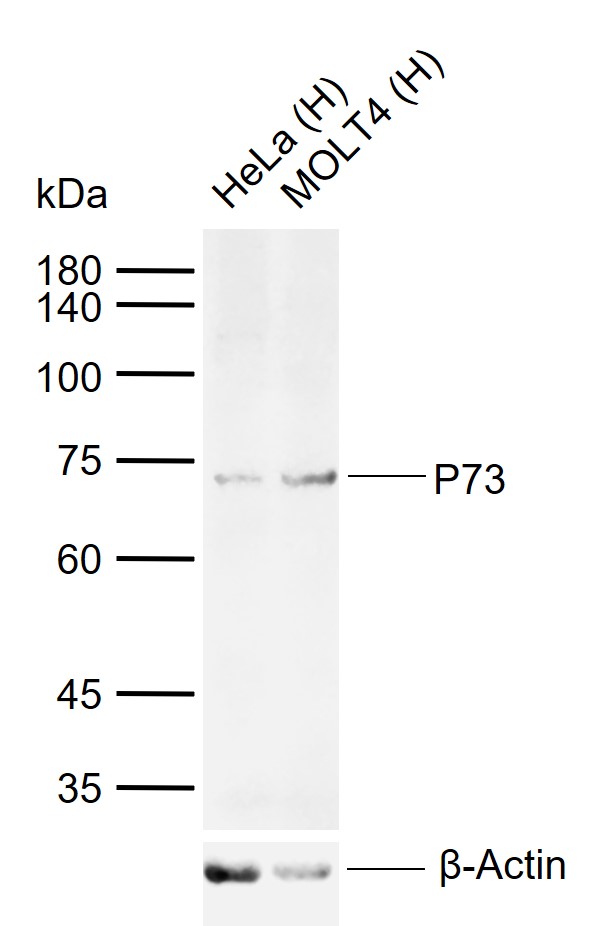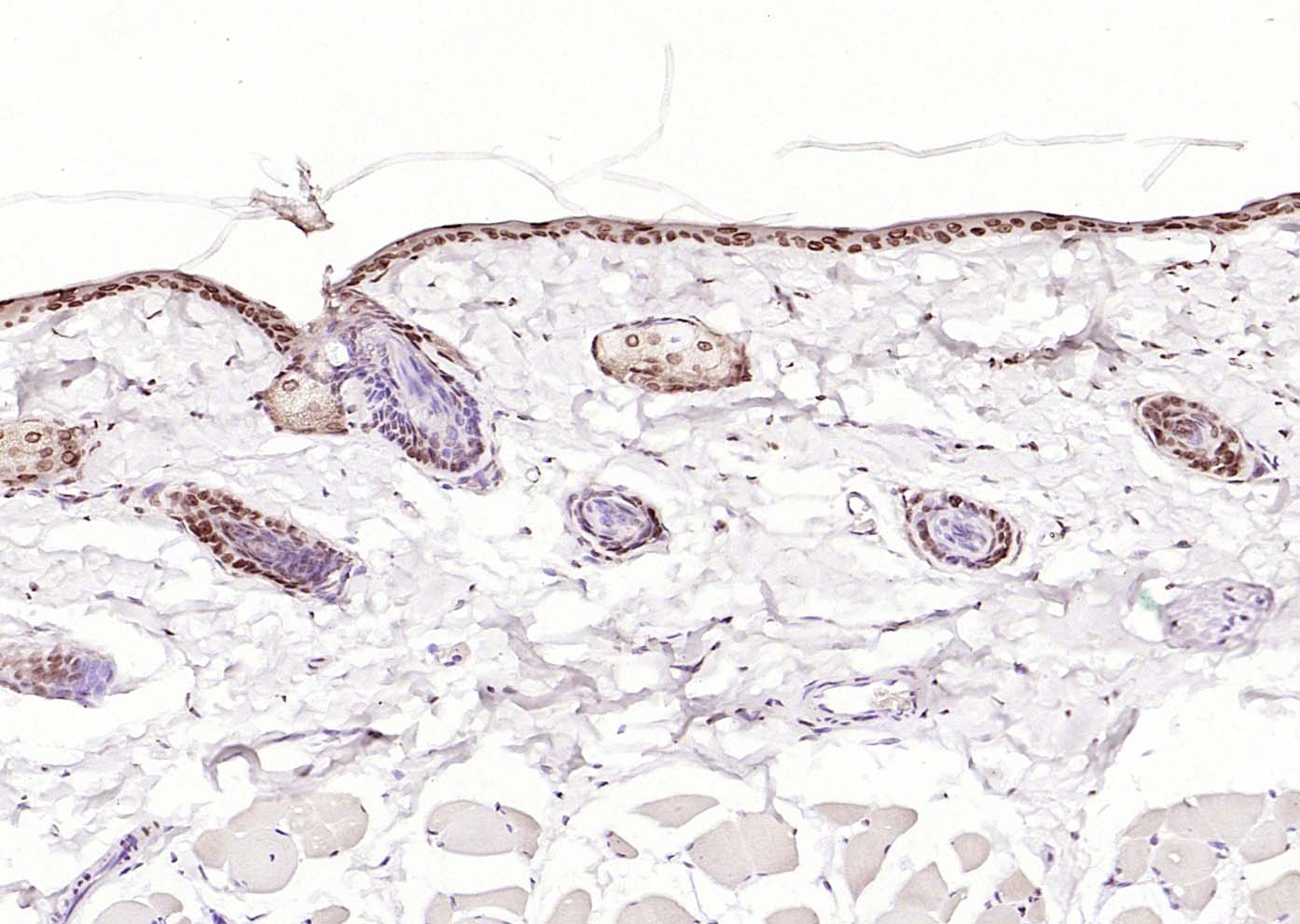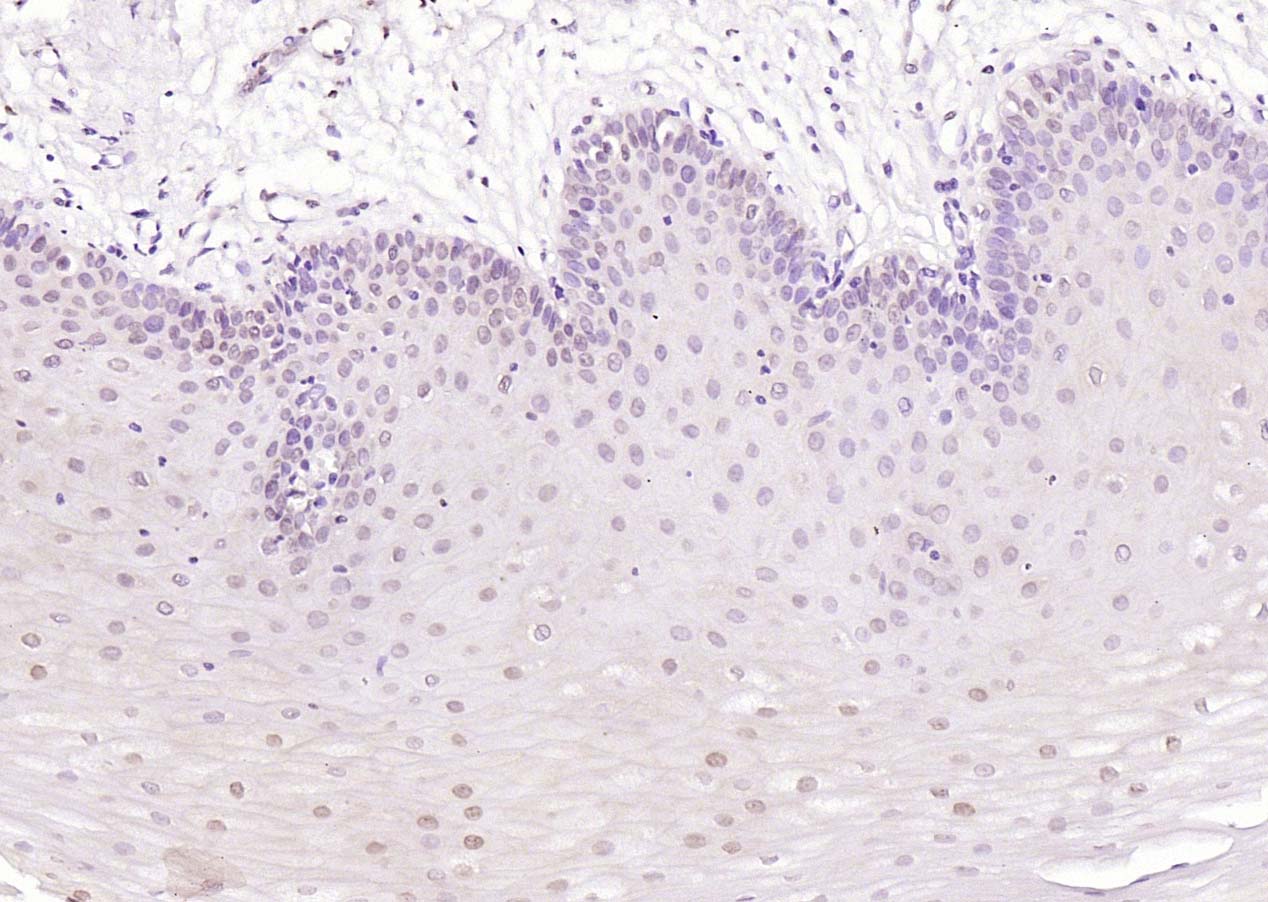
Rabbit Anti-P73 antibody
P73_HUMAN; Tumor protein p73; p53-like transcription factor; p53-related protein; TP73; p53 Related Protein; CILD47;
View History [Clear]
Details
Product Name P73 Chinese Name Tumour蛋白P73抗体 Alias P73_HUMAN; Tumor protein p73; p53-like transcription factor; p53-related protein; TP73; p53 Related Protein; CILD47; Research Area Tumour immunology Immunogen Species Rabbit Clonality Polyclonal React Species Human, Rat, (predicted: Mouse, Dog, Cow, Sheep, ) Applications WB=1:500-2000 ELISA=1:5000-10000 IHC-P=1:100-500 (Paraffin sections need antigen repair)
not yet tested in other applications.
optimal dilutions/concentrations should be determined by the end user.Theoretical molecular weight 70kDa Cellular localization The nucleus cytoplasmic Form Liquid Concentration 1mg/ml immunogen KLH conjugated synthetic peptide derived from mouse p73 alpha: 301-350/636 Lsotype IgG Purification affinity purified by Protein A Buffer Solution 0.01M TBS(pH7.4) with 1% BSA, 0.03% Proclin300 and 50% Glycerol. Storage Shipped at 4℃. Store at -20 °C for one year. Avoid repeated freeze/thaw cycles. Attention This product as supplied is intended for research use only, not for use in human, therapeutic or diagnostic applications. PubMed PubMed Product Detail This gene encodes a member of the p53 family of transcription factors involved in cellular responses to stress and development. It maps to a region on chromosome 1p36 that is frequently deleted in neuroblastoma and other tumors, and thought to contain multiple tumor suppressor genes. The demonstration that this gene is monoallelically expressed (likely from the maternal allele), supports the notion that it is a candidate gene for neuroblastoma. Many transcript variants resulting from alternative splicing and/or use of alternate promoters have been found for this gene, but the biological validity and the full-length nature of some variants have not been determined. [provided by RefSeq, Feb 2011].
Function:
Participates in the apoptotic response to DNA damage. Isoforms containing the transactivation domain are pro-apoptotic, isoforms lacking the domain are anti-apoptotic and block the function of p53 and transactivating p73 isoforms. May be a tumor suppressor protein. [COFACTOR] Binds 1 zinc ion per subunit
Subunit:
Found in a complex with p53/TP53 and CABLES1. The C-terminal oligomerization domain binds to the ABL1 tyrosine kinase SH3 domain. Interacts with HECW2. Isoform Beta interacts homotypically and with p53/TP53, whereas isoform Alpha does not. Isoform Gamma interacts homotypically and with all p73 isoforms. Isoform Delta interacts with isoform Gamma, isoform Alpha, and homotypically. Isoforms Alpha and Beta interact with HIPK2. Isoform Alpha interacts with RANBP9. Isoform Beta interacts with WWOX. Interacts (via SAM domain) with FBXO45 (via B30.2/SPRY domain). Interacts with YAP1 (phosphorylated form). Interacts with HCK (via SH3 domain); this inhibits TP73 activity and degradation.
Subcellular Location:
Nucleus. Cytoplasm. Note=Accumulates in the nucleus in response to DNA damage.
Tissue Specificity:
Expressed in striatal neurons of patients with Huntington disease (at protein level). Brain, kidney, placenta, colon, heart, liver, spleen, skeletal muscle, prostate, thymus and pancreas. Highly expressed in fetal tissue.
Post-translational modifications:
Isoform alpha (but not isoform beta) is sumoylated on Lys-627, which potentiates proteasomal degradation but does not affect transcriptional activity. Phosphorylation by PLK1 and PLK3 inhibits the transcription regulator activity and pro-apoptotic function.
Higher levels of phosphorylation seen in the brain from patients with Huntington disease.
Polyubiquitinated by RCHY1/PIRH2; leading to its degradation by the proteasome.
Similarity:
Belongs to the p53 family.
Contains 1 SAM (sterile alpha motif) domain.
SWISS:
Q9JJP2
Gene ID:
22062
Database links:Entrez Gene: 7161 Human
Entrez Gene: 22062 Mouse
Omim: 601990 Human
SwissProt: O15350 Human
SwissProt: Q9JJP2 Mouse
Unigene: 697294 Human
Unigene: 706990 Human
Unigene: 78015 Mouse
Product Picture
Lane 1: Mouse Spleen tissue lysates
Lane 2: Mouse Kidney tissue lysates
Primary: Anti-P73 (SL6147R) at 1/200 dilution
Secondary: IRDye800CW Goat Anti-Rabbit IgG at 1/20000 dilution
Predicted band size: 70 kDa
Observed band size: 73 kDa
Sample:
Lane 1: Human HeLa cell lysates
Lane 2: Human MOLT4 cell lysates
Primary: Anti-P73 (SL6147R) at 1/1000 dilution
Secondary: IRDye800CW Goat Anti-Rabbit IgG at 1/20000 dilution
Predicted band size: 70 kDa
Observed band size: 73 kDa
Paraformaldehyde-fixed, paraffin embedded (rat skin); Antigen retrieval by boiling in sodium citrate buffer (pH6.0) for 15min; Block endogenous peroxidase by 3% hydrogen peroxide for 20 minutes; Blocking buffer (normal goat serum) at 37°C for 30min; Antibody incubation with (p73 alpha) Polyclonal Antibody, Unconjugated (SL6147R) at 1:200 overnight at 4°C, followed by operating according to SP Kit(Rabbit) (sp-0023) instructionsand DAB staining.Paraformaldehyde-fixed, paraffin embedded (human esophagus); Antigen retrieval by boiling in sodium citrate buffer (pH6.0) for 15min; Block endogenous peroxidase by 3% hydrogen peroxide for 20 minutes; Blocking buffer (normal goat serum) at 37°C for 30min; Antibody incubation with (p73 alpha) Polyclonal Antibody, Unconjugated (SL6147R) at 1:200 overnight at 4°C, followed by operating according to SP Kit(Rabbit) (sp-0023) instructionsand DAB staining.
References (0)
No References
Bought notes(bought amounts latest0)
No one bought this product
User Comment(Total0User Comment Num)
- No comment






 +86 571 56623320
+86 571 56623320
 +86 18668110335
+86 18668110335

